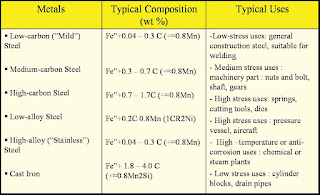 Material
Classification Techniques:
Material
Classification Techniques:
Broadly speaking
engineering materials can be classified into:
1. Material metal
2. Nonmetallic
Materials
Based on the chemical
composition of metals and alloys can be divided into two groups, namely:
1. Metal ferrous /
ferrous
2. Metals non ferrous
/ non-ferrous
Ferrous metals are
metals and alloys containing iron (Fe) as a main element.
Non-ferrous metals is
a materiality that contain little or no iron. In the world of mechanical
engineering, metals (mainly ferrous metals / steel) is the most widely used
material, but other materials also can not be ignored. Non-metallic materials
are often used because of the materiality has distinctive features that are not
owned by the metal material.
Non-metallic materials
can be divided into several categories, namely:
1. Ceramic
2. Plastic (polymer)
3. Composite
The ceramic material
is a material formed from the compound (compound) between one or more metal
elements (including Si and Ge) with one or more non-metallic elements. ceramic
type material is increasingly being used, from a variety of abrasives, cutting
chisel, refractory stone, glass, and others, even rocket technology and space
flight is in need of ceramic.
Plastic (polymer)
material is a result of human engineering, is a very long-chain molecules and molecules
that bind to each other MER. The use of plastic is also very wide, from
household appliances, car interior, cabinet radio / television, until
construction machinery.
Composite material is
the result of a combination of two or more materials, that is very different
from the properties of each material origin. Composite addition is made of the
results of human engineering, also can occur naturally, such as wood, which is
composed of cellulose fibers which are in a matrix of lignin. Composites is currently
widely used in aircraft construction, as have the nature of light, strong and
non magnetic.
Mechanical properties
are properties that express the ability of a material / component for receiving
the load, force and energy without causing damage to materials / components.
Some important
mechanical properties, among others:
1. Strength (strength)
Is the ability of a
material to receive the voltage without causing material be broken. Based on
the type of work load, the power is divided into several types namely tensile
strength, shear strength, compressive strength, torsion strength and bending
strength.
2. Rigidity
(stiffness)
Is the ability of a
material to receive the voltage / load without causing deformation or difleksi.
3. elasticity
(elasticity)
Meterial defined as
the ability to receive voltage without resulting in permanent deformation after
the voltage is removed, or in other words the ability of a material to return
to its original size and shape after being deformed (deformation).
 4. plasticity
(plasticity)
4. plasticity
(plasticity)
The ability of a
material to undergo plastic deformation (permanent deformation) without
sustaining damage. The material has high plasticity is said to be a resilient
material (ductile), while materials having low plasticity of the material is
said to be brittle (brittle).
5. Tenacity
(ductility)
Is sutu material
properties described bleak cable with a tensile strength applications. The
ductile material must be strong and flexible. Tenacity is typically measured with
a given period, the percentage of strain. This property is usually used in
perteknikan midwives, and materials that have these properties include soft
iron, copper, aluminum, nickel, etc.
6. toughness
(toughness)
Is a material's
ability to absorb some of the energy without causing any damage.
7. brittleness
(brittleness)
Is a material that has
properties opposite to ductility properties. This fragility is a rupture
properties of a material with a slight shift permanent. The material is also
fragile, subject to tensile load, without giving too much of strain. Examples
of materials that have the properties of this fragility is cast iron.
8. Fatigue (fatigue)
Is the tendency of the
metal to be broken when receiving alternating load (dynamic load), the amount
is still well below the elastic stiffness.
9. stretchy (creep)
Is the tendency of a
metal to plastic deformation when loading the relative magnitude is still being
done in a long time at a high temperature.
10. Violence
(hardness)
A material resistance
to compression or indentation / penetration. This relates to the nature of wear
resistant properties (wear resistance) is the resistance of a material to
scratching or abrasion.
load
Defined as an external
force that supports sutau part of the machine. The load consists of three
types, namely:
fixed expenses (steady load), said fixed load when the load





















